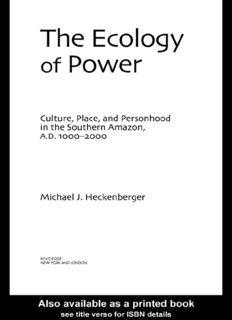
The Ecology of Power: Culture, Place and Personhood in the Southern Amazon, AD 1000-2000 (Critical Perspectives in Identity, Memory & the Built Environment) PDF
Preview The Ecology of Power: Culture, Place and Personhood in the Southern Amazon, AD 1000-2000 (Critical Perspectives in Identity, Memory & the Built Environment)
The Ecology Power of CRITICAL PERSPECTIVESIN IDENTITY, MEMORY,ANDTHE BUILT ENVIRONMENT HELAINE SILVERMAN, UNIVERSITYOF ILLINOISAT URBANA-CHAMPAIGN, SERIES EDITOR Places in Mind: Archaeology as Applied Anthropology edited by Paul A. Shackel and Erve Chambers Identity and Power in the Ancient Andes: Tiwanaku Cities through Time John Wayne Janusek The Ecology Power of Culture(cid:1) Place(cid:1) and Personhood in the Southern Amazon(cid:1) A(cid:2)D(cid:2) (cid:3)(cid:4)(cid:4)(cid:4)–(cid:5)(cid:4)(cid:4)(cid:4) Michael J(cid:2) Heckenberger ROUTLEDGE NEW YORK AND LONDON Published in 2005 by Routledge Taylor & Francis Group 270 Madison Avenue New York, NY 10016 www.routledge-ny.com Published in Great Britain by Routledge Taylor & Francis Group 2 Park Square Milton Park, Abingdon Oxon OX14 4RN www.routledge.co.uk Copyright © 2005 by Taylor & Francis Group, a Division of T&F Informa. Routledge is an imprint of the Taylor & Francis Group. This edition published in the Taylor & Francis e-Library, 2005. “To purchase your own copy of this or any of Taylor & Francis or Routledge’s collection of thousands of eBooks please go to www.eBookstore.tandf.co.uk.” All rights reserved. No part of this book may be reprinted or reproduced or utilized in any form or by any electronic, mechanical or other means, now known or hereafter invented, including photo- copying and recording or in any information storage or retrieval system, without permission in writing from the publishers. All author’s royalties from the sale of this book will be donated to Associação Indígena Kuikuro do Alto Xingu Library of Congress Cataloging-in-Publication Data Heckenberger, Michael. The ecology of power : culture, place, and personhood in the southern Amazon, AD 1000-2000 / Michael J. Heckenberger. p. cm. – (Critical perspectives in identity, memory, and the built environment) Includes bibliographical references and index. ISBN 0-415-94598-4 (hb : alk. paper) – ISBN 0-415-94599-2 (pb : alk. paper) 1. Indians of South America–Brazil–Xingu River Valley–History. 2. Indians of South America–First contact with Europeans–Brazil–Xingu River Valley. 3. Indians of South America–Brazil–Xingu River Valley–Social life and customs. 4. Chiefdoms–Brazil–Xingu River Valley. 5. Xingu River Valley (Brazil)–History. 6. Xingu River Valley (Brazil)–Colonization. 7. Xingu River Valley (Brazil)–Social life and customs. I. Title. II. Series. F2519.1.X56H43 2004 981’.72–dc22 2004015651 ISBN 0-203-48662-5 Master e-book ISBN ISBN 0-203-57708-6 (Adobe eReader Format) Dedicated to my parents, Mary and Victor and Afukaká, teacher, friend, and “brother.” Contents Preface xi Illustrations xix List of Tables xxv CHAPTER 1 Introduction 1 Broken Mirrors: Amazonia as Imagined World 6 Lost Civilizations, Again? 14 History, Ecology, and Power 19 PART I Visualizing Deep Temporality 29 CHAPTER 2 Culture and History: The Longue Durée 37 The Southern Amazon 42 The Southern Periphery 56 Xinguano Cultural Schema 60 CHAPTER 3 Traces of Ancient Times 67 Basic Chronology 68 A Tale of Two Towns: The Western Complex 75 The Eastern Complex 103 vii viii •Contents CHAPTER 4 Social Dynamics Before Europe 113 A Thread of Ariadne 117 Ancient Xinguano Regime as Galactic Polity 124 War and Peace in the Age of Inka 133 CHAPTER 5 In The Shadow of Empire: Colonialism and Ethnogenesis 143 A Brief History of “Contact” 147 The Construction of Xinguano Pluralism 152 Demography and Social Change 163 PART II Body, Memory, and History 179 CHAPTER 6 Landscape and Livelihood: The Ethos of Settled Village Life 191 Making a Living 192 Basic Diet 198 Objects as Subjects 201 Pottery 209 Productivity 216 CHAPTER 7 In The Midst of Others: Landscapes of Memory 223 The Mirror World of Dawn Time 227 The Skin of the Land 230 Village and Countryside 236 Place and Place-Making: The Sites of Memory 242 Visualizing Landscape: Memory and Representation 250 CHAPTER 8 Houses, Heroes, and History: The Fractal Person 255 Xinguano Social Memory: Enchainments 258 Chiefs and Others 269 Village as “House” 284 Contents• ix CHAPTER 9 The Symbolic Economy of Power: Plazas as Persons 291 The Xinguano Plaza 293 Making Chiefs 296 Socio-Ethnophysics 302 Plazas as Persons 306 The Symbolic Economy of Power 312 CHAPTER 10 Conclusion: The Pedigree of a Contradiction 319 Persons Large and Small 322 Chiefdoms, or What? 325 Big-Men, Great-Men, Chiefs, and Others 331 The Structural Contradiction and the Theater State 336 Notes 349 Bibliography 361 Orthography and Glossary of Indigenous Terms 385 Index 397
Description: